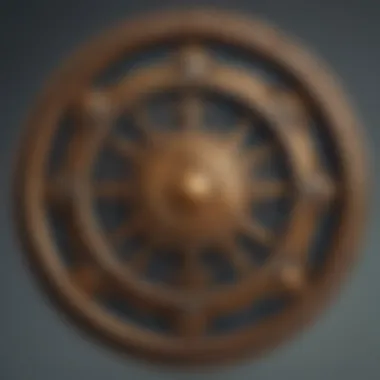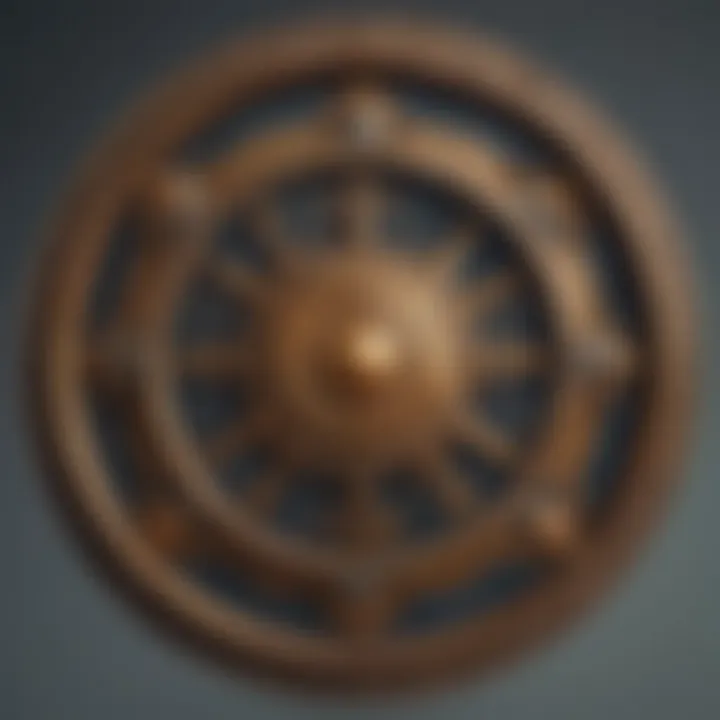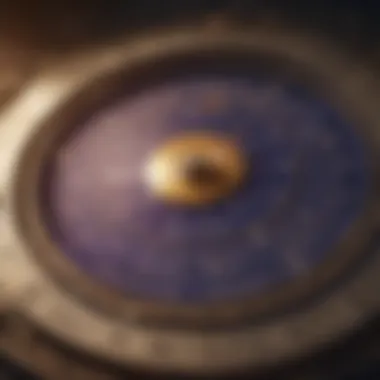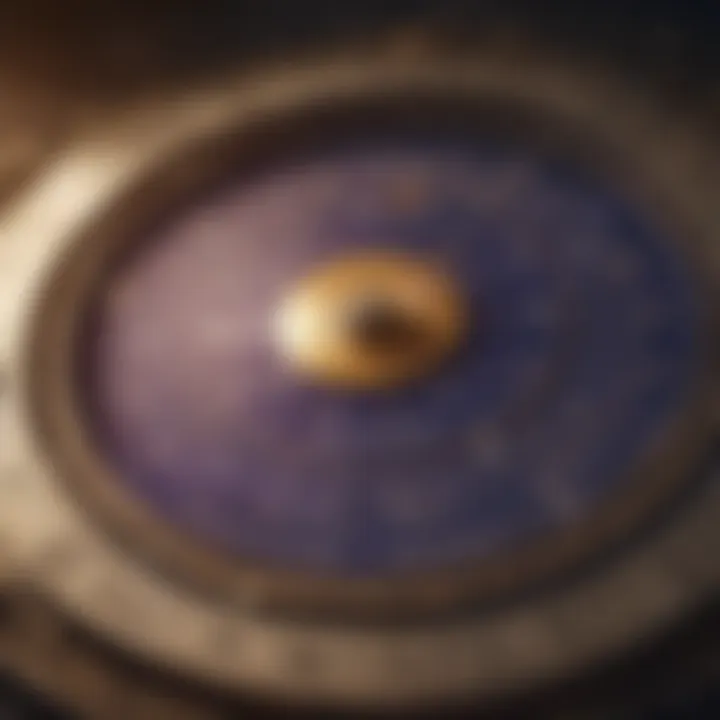Understanding the Importance of Free Birth Chart Readings


Intro
[Understanding the Zodiac]
Overview of Zodiac Signs
The zodiac is divided into twelve distinct signs, each lending its own flavor to the personality traits and experiences of individuals born under its influence. Whether you’re a fiery Aries or a dreamy Pisces, every sign embodies unique characteristics.
- Aries: Bold and adventurous, they are natural leaders.
- Taurus: Grounded and determined, they value stability.
- Gemini: Sociable and witty, they thrive on communication.
- Cancer: Sensitive and nurturing, they prioritize family.
- Leo: Charismatic and courageous, they shine bright.
- Virgo: Detail-oriented and analytical, they seek perfection.
- Libra: Diplomatic and fair, they value harmony.
- Scorpio: Intense and passionate, they delve deep.
- Sagittarius: Adventurous and philosophical, they chase freedom.
- Capricorn: Ambitious and disciplined, they aim for success.
- Aquarius: Innovative and independent, they break boundaries.
- Pisces: Compassionate and artistic, they embrace dreams.
Understanding where you fall within these archetypes can deepen your awareness of personal tendencies and interactions with others.
Sign Traits and Characteristics
Each sign comes with a unique set of traits that influences behavior, preferences, and even life choices. Recognizing these traits can guide how you approach both your professional and personal life. For example, Scorpio's penchant for intensity may translate into career choices that involve investigation or research, while a Libra's affinity for balance may lead them towards roles in mediation or diplomacy.
Elemental Qualities
The twelve zodiac signs are grouped into four elemental qualities: Fire, Earth, Air, and Water. Each element signifies a different mode of expression:
- Fire signs (Aries, Leo, Sagittarius): Assertive and passionate.
- Earth signs (Taurus, Virgo, Capricorn): Practical and stable.
- Air signs (Gemini, Libra, Aquarius): Intellectually driven and communicative.
- Water signs (Cancer, Scorpio, Pisces): Intuitive and emotional.
By recognizing your elemental qualities, you can gain insight into your natural tendencies and the best environments for your growth.
Astrological Insights
With a grasp of the zodiac, let’s dive into how current cosmic influences mold individual experiences.
Current Astrological Trends
Astrology reflects the dance of planets as they transition through the zodiac. For instance, a Mercury retrograde might herald communication challenges, while a New Moon often signifies fresh beginnings. Keeping an eye on these trends allows you to navigate your daily life with greater awareness and preparedness.
Influence of Celestial Events
Whenever a celestial event occurs, its implications can ripple down to Earth. Eclipses often herald transformational phases, while the alignment of Jupiter brings opportunities for expansion. Knowing when these events happen can help in planning significant decisions or new ventures.
How to Interpret Your Birth Chart
Interpreting a birth chart involves more than just knowing your sun sign. It encompasses the positions of other celestial bodies like the Moon, Mercury, and Venus at the time of your birth. Learning to read these elements equips you with the roadmap to personal understanding.
"Your birth chart isn't just about the 'stars aligning'; it's about you aligning with your true self."
Horoscope and Predictions
Understanding past trends and celestial movements can shape future predilections, leading to a more fulfilling journey.
Monthly or Weekly Forecasts
Regular horoscopes provide insights into the energies at play. For instance, a Virgo may be advised to focus on organization, while a Leo could be urged to embrace their creative side.
Personalized Horoscope Reading
Personalized horoscope readings go beyond the generalized daily or monthly forecasts. They take into account specific placements in your birth chart, weaving together a narrative that aligns with your individual path.
Compatibility Readings Based on Zodiac Signs
Compatibility readings help understand how different signs interact. While a Taurus may find a natural connection with a Capricorn, an Aquarius might clash with a Scorpio. Knowing your compatibility can help navigate relationships with greater empathy and awareness.
Prolusion to Free Birth Chart Readings
Astrology has always been a subject that stirs curiosity and introspection. The fascination with how celestial bodies influence our lives is prominent in many cultures. Therefore, the concept of free birth chart readings holds significant importance in the field of astrology. Essentially, a birth chart is a snapshot of the sky at the exact moment of one's birth, mapping out the placements of planets, zodiac signs, and houses.
Defining Birth Charts
A birth chart, also known as a natal chart, is more than just a compilation of astrological data. It’s a personalized cosmic blueprint that encapsulates the energies and potentialities unique to an individual. Each component—the planets, signs, and houses—work in harmony to convey a deeper meaning. Stars and planets don’t simply sit in the sky without purpose; they interact, creating a complex tapestry of influences that can shape personality traits, life events, and emotional states.
Having an accurate birth chart allows an astrologer to decode these influences and provide insights that can lead to personal growth. If the individual understands what each planetary placement signifies, it helps in navigating life’s ups and downs more thoughtfully. The beauty lies in the details; even something as small as the degree of a planet's position or the aspect it creates with another planet can make a world of difference when it comes to interpretation.
The Appeal of Free Services
In today’s digital age, the availability of free services has revolutionized how individuals access knowledge. Free birth chart readings are particularly appealing for several reasons. For one, they allow people to dip their toes into astrology without the risk of financial commitment. Many who may be skeptical or uninformed about astrology find comfort in exploring free resources before deciding if they want to invest in a more personalized service.
Moreover, the democratization of astrological insights caters to a wider audience. Individuals from various backgrounds and financial means can access the information that was once reserved for those who could afford it. The accessibility of information fosters a sense of community, as people share their experiences, interpretations, and even discrepancies between different chart readings.


In essence, free birth chart readings can act as a gateway into the larger realm of astrology, inviting individuals to explore their cosmic influences without barriers.
"Astrology is the cosmic code that helps one understand their place in the universe, offering reflections not just of celestial events, but of personal journeys as well."
With the initial understanding established, let’s delve deeper into the components that make up a birth chart and what they signify.
Components of a Birth Chart
When delving into the realm of astrology, one cannot overlook the foundational elements that make up a birth chart. Each component plays a significant role, revealing insights about personality, motivations, and potential life paths. Understanding these elements not only enhances your knowledge of astrology but also provides a blueprint for personal development and self-awareness.
A birth chart, often referred to as a natal chart, is a snapshot of the sky at the moment of an individual's birth. It reveals the positions of heavenly bodies such as the planets, the Sun, and the Moon, across different signs and houses. Each of these components comes together to create a comprehensive portrait of a person's astrological identity. Recognizing how they interact can lead to profound revelations about one’s traits, strengths, and challenges.
Zodiac Signs: The Twelve Archetypes
Zodiac signs are perhaps the most familiar aspect of astrology. They represent twelve distinct archetypes that embody broad traits and characteristics. Each sign corresponds to a segment of the ecliptic, where the sun appears to travel throughout the year. Here's a closer look at what the signs signify:
- Aries (March 21 - April 19): Bold, ambitious, and sometimes impulsive.
- Taurus (April 20 - May 20): Reliable, patient, and indulgent, valuing comfort and stability.
- Gemini (May 21 - June 20): Curious, quick-witted, and adaptable, sometimes seen as indecisive.
- Cancer (June 21 - July 22): Nurturing, protective, and deeply intuitive, often connected to home and family.
- Leo (July 23 - August 22): Charismatic, enthusiastic, and a natural leader, craving attention and appreciation.
- Virgo (August 23 - September 22): Analytical and detail-oriented, often critical yet deeply empathetic.
- Libra (September 23 - October 22): Diplomatic and harmonious, with a keen sense of fairness.
- Scorpio (October 23 - November 21): Intense, passionate, and secretive, drawn to deeper truths.
- Sagittarius (November 22 - December 21): Adventurous, optimistic, and philosophical, but sometimes reckless.
- Capricorn (December 22 - January 19): Disciplined, responsible, and often ambitious, with a focus on achievement.
- Aquarius (January 20 - February 18): Innovative, unconventional, and humanitarian, often seen as aloof.
- Pisces (February 19 - March 20): Compassionate, imaginative, and sensitive, often engaging deeply with the world’s emotions.
These archetypes frame a person’s approach to life and relationships, serving as guides for understanding behavioral patterns and tendencies.
Houses: The Phases of Life
Just as important as the zodiac signs are the houses in a birth chart. Each house, twelve in total, represents different areas of life:
- First House: Self-image and physical appearance.
- Second House: Money, possessions, and values.
- Third House: Communication and immediate environment.
- Fourth House: Home, roots, and familial connections.
- Fifth House: Creativity, romance, and self-expression.
- Sixth House: Daily work, health, and routines.
- Seventh House: Partnerships and significant relationships.
- Eighth House: Transformation, shared resources, and intimacy.
- Ninth House: Philosophy, travel, and higher learning.
- Tenth House: Career, social status, and public life.
- Eleventh House: Friendships, community, and aspirations.
- Twelfth House: Subconscious, isolation, and spiritual growth.
The interplay between the houses and zodiac signs informs how an individual experiences these life areas. This can help one prioritize their life path and make sense of personal challenges and opportunities.
Planets: The Driving Forces
Lastly, the planets act as the engines of astrological influence. Each planet signifies specific aspects of life and personality:
- Sun: Represents core identity and ego.
- Moon: Governs emotions, instincts, and unconscious patterns.
- Mercury: Influences communication styles and thinking.
- Venus: Relates to love, beauty, and attraction.
- Mars: Represents action, desire, and aggression.
- Jupiter: Associated with growth, optimism, and expansion.
- Saturn: Represents discipline, boundaries, and structure.
- Uranus: Governs innovation, rebellion, and sudden changes.
- Neptune: Relates to dreams, intuition, and mysticism.
- Pluto: Symbolizes transformation, power, and the subconscious.
Each planet's placement in a particular sign and house marks unique influences in an individual’s life. Understanding these driving forces and their relationships to each other is crucial for gaining insights into one's character and potential life trajectory.
By comprehending the primary elements that compose a birth chart, individuals can deepen their astrological knowledge and leverage this understanding for self-discovery and growth. Ultimately, this exploration into the components serves as a foundation for interpreting a personal birth chart and understanding one’s journey through life, making astrology a profoundly personal and empowering tool.
Obtaining Your Free Birth Chart
Understanding how to obtain your free birth chart is pivotal in journey through astrology. Knowing how to access your chart can deepen your insight into personal traits, potential, and life patterns. A birth chart serves as a unique snapshot of the sky at your moment of birth, making it a significant foundation for self-discovery.
Key Information Required
To create an accurate birth chart, you need some specific details about yourself. Let's drill down into three key pieces of information: your date of birth, time of birth, and place of birth.
Date of Birth
The date of birth is the cornerstone of any birth chart reading. It marks the starting point for calculating planetary positions. This is not just a simple number; it plays a major role in defining your astrological identity. Different planetary influences are associated with every date, which means your unique traits are embedded in this very information.
A major characteristic of your date of birth is its relationship to astrological signs. Each sign has its own vibes and energies, and they reflect your personality at a keen level. This makes it a popular choice among astrologers for their predictive abilities and insights indeed.
One unique feature about the date of birth is that it defines your Sun sign, which many people find they identify with the most. However, it’s worth noting that this alone is just the tip of the iceberg—there's so much more complexity in your entire chart.
Time of Birth
Next up is the time of birth. Believe it or not, even a few minutes can make a difference in your birth chart. This aspect is crucial for determining the exact positioning of the planets and the ascendant or rising sign, which affects how you present yourself to the world.
The key characteristic here is precision. Having a specific time allows for a much more tailored and nuanced reading. This is why it's regarded as so beneficial in astrology. Without it, many insights might be missed.
A unique feature about time of birth is its link to your rising sign. Your rising sign influences how others perceive you and it shapes your outward behavior. It’s like your astrological mask, which adds a rich layer of complexity.
Place of Birth
Last, but not least, is the place of birth. This geographic information influences which houses the planets occupy in your chart. Each house represents different life areas, from relationships to career and beyond, so this detail is essential.
The key trait of place of birth is its role in anchoring your astrological chart to a specific location. It situates your personal transits against the cosmic backdrop. This element makes it particularly appealing for those looking to delve deeper.
A unique aspect of place of birth is its connection to local astrology. Different regions may have varying interpretations based on cultural astrological practices, adding another layer to your birth chart’s significance.
"Knowing the details of your birth is not just a ritual; it's a vital part of forming an astrological identity that reveals layers of self-awareness."
Choosing a Reliable Online Tool


Once you have your birth details in hand, the next step is to find a reliable online tool to generate your free birth chart. Not every tool is created equal, and one must consider a few factors while selecting the right one. Look for tools that provide comprehensive interpretations as well as accurate chart generation. Check user reviews and perhaps see if the site has a knowledgeable community backing it—this can make all the difference.
Interpreting Your Birth Chart
Interpreting your birth chart serves as the linchpin of astrological understanding. It allows individuals to dive deep into the cosmic blueprint that outlines their life’s potential, challenges, and inherent tendencies. It is more than just numbers and symbols on paper; it’s a roadmap of who we are and who we might become. Knowing how to interpret various components—planetary placements, aspects, and the synthesizing of chart elements—can indeed help anyone unlock insights that steer personal growth and relationships in more meaningful directions.
Understanding Planetary Placements
Every celestial body in your birth chart bears its weight in influence. Consider the planets as players in a drama: each carries unique traits and characteristics that interact with the other elements of your chart. For instance, the Sun often represents the core self—your essence, while the Moon governs emotional realms and the instinctive reactions. Their position in the zodiac signs and houses reveals how these influences express themselves in one’s life.
For instance, someone with their Sun in Leo might have a strong desire to shine and be recognized, while a Moon in Pisces may indicate sensitivity and a rich inner world. These placements serve as signposts, highlighting the strengths and struggles people may face. Recognizing and embracing this can empower you.
Reading Aspects and Angles
The relationship between the planets—understood through aspects and angles—provides a deeper layer of interpretation. Aspects can be viewed as conversations between planets: Are they in harmony? Are they at odds? These relationships tell us about potential conflicts and synergies in life.
- Conjunctions suggest a merging of energies, often leading to intense focus.
- Squares can indicate obstacles or tensions, igniting challenges that often lead to growth.
- Trines and Sextiles, on the other hand, are harmonious aspects, often bringing ease and talent that may flow naturally.
Understanding these dynamics can shine a light on how one can harness both constructive energies and challenges in their lives. If we revisit our earlier planetary characters, a square between a Leo Sun and a Scorpio Moon could yield a scenario where one's drive for recognition clashes with deep, emotional needs, leading to inner turmoil but also potential for growth.
"The soul would have no rainbow if the eyes had no tears."
Synthesizing Chart Elements
Finally, synthesizing the various elements of your birth chart involves weaving together the narratives told by planetary placements, aspects, and houses into a cohesive understanding. This is where true insight blossoms. Rather than looking at each part in isolation, consider the interconnected web they create.
For example, if your Venus is in Virgo and is square to your Mars in Gemini, this tells a story about love and desire. It can signal difficulties in expressing affection due to overthinking, creating a push-pull in relationships. By understanding this configuration, you can start to address these patterns, experimenting with communication and emotional delivery in relationships.
Ultimately, the ability to synthesize these components allows an individual to move beyond basic interpretations, fostering a deeper comprehension of how various astrological influences interact and impact life. The art of astrology lies in interpretation—the weaving together of complexities to reveal clearer paths towards self-understanding and personal growth.
The Role of Astrology in Self-Discovery
Astrology has long been viewed as a mystical guide offering insights into our personalities and life paths. However, its role transcends mere predictions. When we dig into the realm of birth charts, we tap into a profound opportunity for self-discovery that can be transformative. This section unpacks the layers of how astrology serves as a mirror, reflecting our inner workings and guiding us toward greater self-awareness.
Astrology as a Reflective Tool
Astrology becomes a powerful reflective tool when we engage with our birth charts. Consider this: your chart represents the positions of celestial bodies at the moment of your birth. This snapshot serves not just as a map, but as a canvas of potentialities. It’s like holding up a mirror; what you see can be both enlightening and challenging.
The various elements—planets, signs, and houses—coalesce to give insights into your core traits, motivations, and even struggles. For instance, a person with a strong placement of Saturn might grapple with feelings of restriction or duty, encouraging them to explore where they might feel limited in life and how to overcome those limitations. This awareness can prompt a person to examine their habits and patterns, ultimately directing them towards personal growth.
"Astrology doesn’t tell you what to do; it shows you what you are capable of and where you can grow."
Embracing astrology as a reflective tool allows individuals to appreciate their unique traits rather than comparing themselves to society's standards. It nurtures a sense of individuality and authenticity, urging you to step into your own story rather than following a scripted narrative. As one delves deeper, journaling about chart insights can reinforce these revelations and act as a catalyst for change. This reflective practice might reveal insecurities or strengths that lead to transformative personal development.
Aligning Actions with Celestial Influences
The beauty of astrology lies in its dynamic relationship with our actions and choices. Many practitioners express that being aware of planetary movements can guide decision-making. For example, launching a project during a Mercury retrograde—when communication might falter—would be ill-advised. Instead, harnessing the energy from positive planetary alignments, such as a Venus transit, can help foster harmonious interactions in relationships.
This alignment doesn’t mean allowing the cosmos to dictate your every move; it’s about synergy. Recognizing these influences empowers individuals to make conscious choices.
- Take action: Use your astrological insights to guide your next steps. When Jupiter, often associated with growth, is prominent in your chart, consider expanding your horizons, whether through education or travel.
- Avoid pitfalls: Understanding when planets are challenging you—say, during a Mars opposition—can help avoid conflict. Use this awareness to refine your communication strategy or handle disputes with opportune timing.
- Cultivate mindfulness: Being educated about how the lunar phases affect your emotions can encourage proactive emotional management. It’s about finding a balance between cosmic guidance and individual agency.
In this dance between celestial influences and personal agency, astrology becomes an empowering ally. Through understanding planetary patterns, you can align your actions in ways that resonate with your inner self, paving the way toward fulfillment and deeper self-discovery.
In summary, astrology is not merely about predicting the future; it forms the backbone of a journey towards richer self-understanding. By engaging with the language of astrology, you unlock pathways to self-awareness and authentic living.
Astrology and Relationship Compatibility
Astrology offers profound insights into the dynamics of relationships. Understanding how celestial bodies influence our interactions can significantly enhance our approach to romantic connections, friendships, and partnerships. This section explores the essential elements of how astrology intersects with relationship dynamics, shedding light on the benefits and considerations involved in using astrological tools for compatibility analysis.
Analyzing Synastry
Synastry involves examining the unique planetary placements of two individuals’ birth charts to uncover the intricate web of their connections. It’s like playing a cosmic matchmaker, revealing how two people can blend and clash based on their individual astrological energies. By comparing each person’s chart, astrologers can identify harmonious aspects—where planets align favorably—and challenging aspects that might lead to friction.
Here are some key factors to consider when analyzing synastry:
- Planetary Aspects: Look for trines and sextiles that suggest ease and support, while squares and oppositions may indicate tension.
- House Overlays: Notice which houses in one partner's chart are activated by the other's planets. For example, if someone's Venus lands in another's seventh house, it's often a sign of romantic attraction.
- Personal vs. Composite Planets: Pay attention to how fast-moving planets (like Moon or Venus) interact, as they reflect immediate feelings and attractions rather than deeper, more long-lasting connections.
"Astrology reveals the dance of the stars, illuminating the rhythms of human connection."
Understanding Composite Charts
Composite charts represent a blend of two individual charts, creating a new entity that reflects the relationship itself as a whole. By calculating the midpoints of each pair of planets, astrologers can craft a unique chart that highlights the relationship’s energies. It acts like a mirror reflecting how the two individuals can create a combined life together.


When interpreting a composite chart, consider the following aspects:
- Emotional Core: The placement of the Moon in the composite chart can indicate how emotional needs are met in the relationship. A well-placed Moon suggests a nurturing environment, while a challenging one might bring about emotional volatility.
- Life Path: The composite Sun symbolizes the essence of the relationship. Its position by zodiac sign and house can suggest the couple's shared goals and identity.
- Challenges and Growth: The harder aspects between planets in the composite chart can shed light on the growth opportunities and potential challenges that the couple can face together.
Astrology provides tools that can lead to greater understanding and empathy in relationships. By exploring aspects such as synastry and composite charts, individuals can navigate their connections with more awareness, enhancing the potential for harmony and mutual growth.
In summation, utilizing these astrological tools not only deepens your understanding of yourself and your partner but can also illuminate the path toward stronger connections and fulfilling relationships.
Challenges in Astrology Interpretation
Astrology doesn't simply live on the surface; it goes deep into the complexities of the heavens above us and the unique chart each individual embodies. Among the most significant hurdles faced by both novice and seasoned astrologers are the interpretation of birth charts and the varying perspectives on the validity of astrological practices.
Navigating these challenges is not just a personal endeavor; it is crucial for enriching one's astrological practice. Gaining clarity on these complexities not only enhances your ability to interpret your chart but also cultivates a more sophisticated understanding of astrology itself. The wisdom hidden within each chart can lead to profound personal insights, provided one approaches it with an open mind and a critical eye.
"Astrology is not about fate; it’s about understanding our potential and the choices we make."
Common Misconceptions
Several misconceptions swirl around astrological practices, often causing confusion for those delving into their interpretations. Here are a few prevalent ideas that can muddle one's understanding:
- Astrology Predetermines Fate: Many newcomers enter the realm of astrology with the belief that everything is preordained. In truth, astrology offers a framework through which individuals can gain insights into their tendencies and motivations, allowing them to make informed choices.
- Charts Are Static: Another common belief is that a birth chart is fixed at the moment of birth. On the contrary, while the core elements remain unchanged, understanding can evolve as you grow and experience life so too does the interpretation of your chart.
- Astrology Is Just Sun Signs: Many people only identify with their Sun sign, overlooking the importance of Moon signs, rising signs, and planetary placements. Each element contributes to the overall picture, creating a rich tapestry that is unique to each person.
Awareness of these misconceptions can significantly improve the depth of interpretation one can achieve, allowing for a more meaningful exploration of astrological insights.
Navigating Complexity in Charts
Interpreting a birth chart can seem akin to trying to solve a complex riddle, with many layers weaving in and out of one another. Each chart is a feedback loop where symbols, houses, and aspects paint a diverse picture of life's potential. Here are key considerations to keep in mind:
- Multiple Planets and Signs: Every individual has multiple planetary positions influencing their behavior and mindset. Keeping track of where Mars, Venus, and Jupiter sit can feel overwhelming but is essential for deeper understanding.
- Aspect Relationships: Aspects are angles between planets, revealing the dynamics of how planetary energies interact. Navigating these can add profound nuances to interpretations, whether they show harmonious interactions or challenging conflicts.
- Chart Synthesis: Rather than piecing apart segments of the chart, developing the skill to synthesize information from different elements creates a fuller picture. Look to see how different planets influence the houses they occupy or how the signs interplay with each other.
Mastering these complexities requires patience and introspection, as developing a nuanced understanding might take time. Engaging in discussions through community forums or joining study groups can be instrumental in refining your skills.
Resources for Further Learning
As we delve into astrology, enhancing one’s knowledge can significantly enrich the experience. Whether you are seeking deeper insights into your birth chart or simply wish to expand your astrological understanding, having access to the right resources is crucial. They offer clarity, a variety of perspectives, and often, a community to discuss ideas. Here’s a breakdown of valuable resources to consider:
Books and Literature
Books are invaluable companions on the journey of astrology. They provide structured information, historical perspectives, and detailed insights into various concepts. A good book might serve as both a guide and an encyclopedia. Consider diving into the following texts:
- The Only Astrology Book You’ll Ever Need by Joanna Martine Woolfolk: This book breaks down fundamental concepts with great ease, making it ideal for beginners.
- Astrology for the Soul by Jan Spiller: Here, readers can explore the significance of lunar nodes in life.
- The Inner Sky by Steven Forrest: Martin combines personal anecdotes with practical insights into the birth chart.
Don’t forget to check local libraries or bookstores. Often, they have sections dedicated to esoteric studies and astrology, presenting unique finds.
Online Courses and Webinars
The digital age has revolutionized how we access knowledge. Online courses and webinars allow individuals to learn at their own pace, making it easier for busy folks to fit astrology into their schedule. Here are a few platforms that can help:
- The Astrology Podcast: Alongside the episodes, they often share resources and recommendations for further learning.
- Astrology University: This website provides a wide variety of courses led by experienced astrologers, covering everything from basics to advanced topics.
- YouTube Channels: Channels like Astrolada and KRSchannel share valuable insights on particular transits, signs, and more. Watching these videos can be a lively complement to reading.
Community Forums and Groups
Connecting with others who share similar interests can open doors to new ideas and discussions. Community forums and groups not only answer questions but also foster relationships and knowledge-sharing. Here are some suggestions:
- Reddit: The r/astrology subreddit offers a hub for discussions, resources, and personal experiences from astrology enthusiasts.
- Facebook Groups: Numerous groups focus on various aspects of astrology, allowing members to post questions, share insights, and discuss their charts in an understanding environment.
- Local Meetups: Check platforms like Meetup.com where you might find astrology groups in your vicinity, enhancing interaction with like-minded individuals.
"The joy of learning is never-ending; every experience adds a new layer to your understanding."
These resources provide a tapestry of knowledge for both novice and seasoned astrologers alike, ensuring a well-rounded approach to mastering astrology.
Cultural Perspectives on Astrology
Astrology doesn’t just sit in a vacuum; it dances through the tapestry of human history, mingling with various cultures and beliefs. Examining different cultural perspectives on astrology enriches our understanding of its relevance and application in everyday life. Each tradition brings its own flavor, traditions, and interpretations, making this peering into the various lenses one can adopt particularly significant for those eager to explore the depth of astrological wisdom.
Western vs. Eastern Astrology
When we look at the Western approach, it often relies on a combination of psychology and mythology. Western astrology sees the natal chart as a psychological blueprint, shaped by celestial bodies and their historical significance within Greco-Roman philosophies. The emphasis tends to be on individual traits, character analysis, and personal growth.
On the flip side, Eastern astrology, particularly that of traditional Chinese philosophy, emphasizes harmony with nature and the collective fate of humanity. Here, one’s essence is often viewed through broader cycles—like the twelve animals of the Chinese zodiac, which reflect the characteristics and trends that can influence not just individuals, but society as a whole as well. While Western astrologers calculate their charts mainly through birth data, Eastern practitioners may also consider lunar cycles and the Five Elements, leading to a more holistic perspective.
“In the East, it’s not just about your personal chart; it’s about how your life fits into the big picture,” says an Eastern astrology practitioner. This difference invites those who are interested in deeper exploration to connect their personal experiences with a wider cultural narrative.
Historical Contexts
The roots of astrology stretch deep into the annals of history. In ancient civilizations like Babylon, astrology was intertwined with religion and used not merely for personal insights, but as a guiding force for entire communities during crucial decisions, like war or crop planting. Such interests weren’t limited to scholarly pursuits but reached into the everyday lives of individuals, shaping cultural and social norms.
In medieval Europe, astrology was considered a scholarly discipline, closely tied to astronomy until the Enlightenment brought skepticism and a focus on empirical science. This historical perspective often sheds light on how contemporary practices became entangled with skepticism and misunderstanding.
Consequently, one must note how the resurgence of astrological interest in modern times, especially among younger generations, serves a dual purpose: to rediscover an ancient wisdom while navigating a fast-paced, ever-changing world. As people seek meaning amid chaos, astrology can offer structured insight, linking it back to its historical function as a predictive tool.
Astrology’s cultural frameworks provide rich soil for understanding how different societies engage with the cosmos, allowing users to navigate their personal journeys with historical precedent. Thus, appreciating these perspectives not only enriches one’s own understanding but also fosters respect for the diversity of beliefs surrounding astrological practices across the globe.







